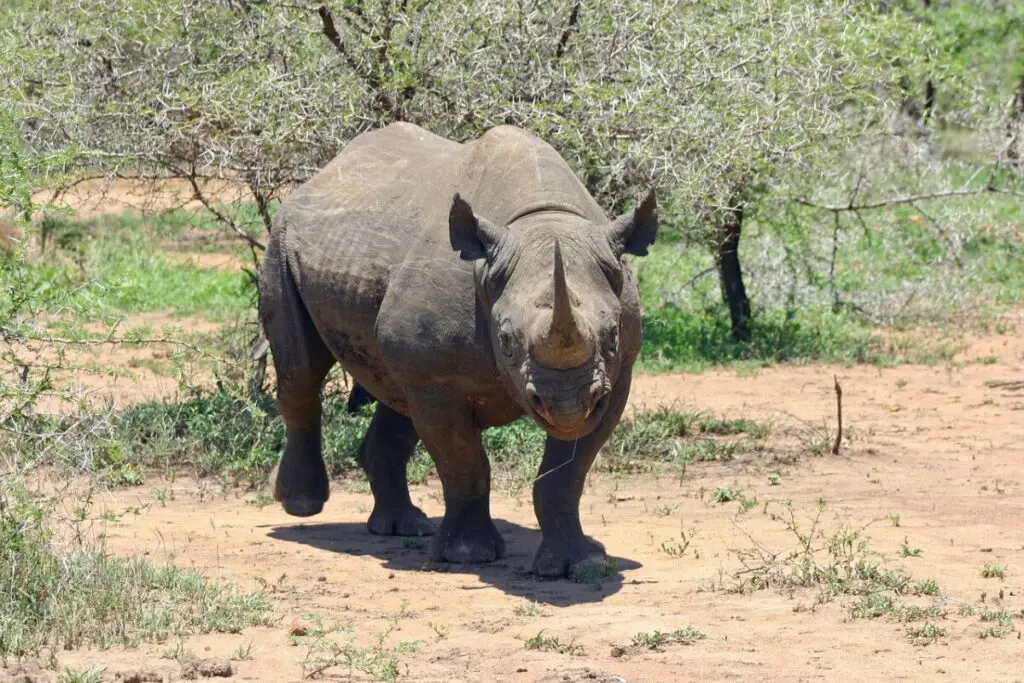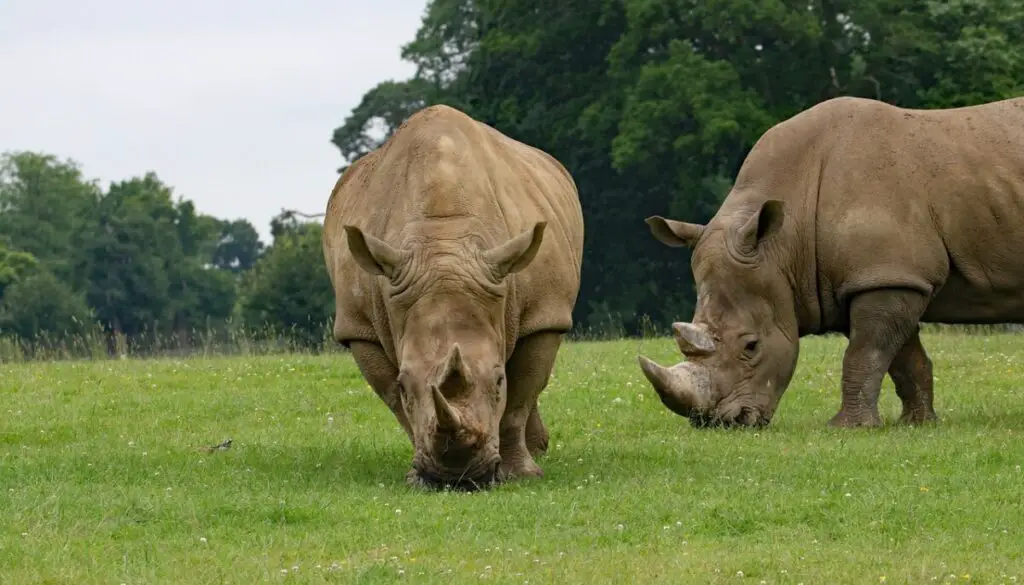The black rhinoceros (Diceros bicornis) is one of the most iconic species on our planet. This majestic creature stands out among the other large mammals and has been a symbol of strength and power for centuries.
Unfortunately, due to poaching and habitat degradation, this species is under serious threat of extinction; however, conservation efforts are underway to save this species from disappearing forever. This article will explore the biology and ecology of the black rhinoceros, as well as its current status in terms of endangerment and potential conservation solutions.
One of the most distinctive features of the black rhino is its size and weight; males can grow up to 1,800 kilograms while females reach around 1,400 kilograms.
Its body shape also differs from other members of Rhinocerotidae family because it has two horns instead of one or three like some others have. Additionally, compared to white rhinos which are mostly grass eaters, black rhinos prefer browse vegetation such as shrubs and trees making them browsers rather than grazers.
Finally, due to human activities such as poaching for their horns which are used in traditional medicine practices in certain parts of Asia and Africa, these animals face extreme pressure that put their population at risk globally with an estimated 4-5 thousand individuals left in 2020 according to The IUCN Red List.
As a result, various strategies including anti-poaching campaigns led by governments together with NGOs have been implemented to protect this species’ remaining populations throughout Africa and prevent further decline.

What Is A Black Rhinoceros?
The black rhinoceros, or Diceros bicornis, is a species of large African mammal that belongs to the Rhinocerotidae family. This animal has two horns on its head and can reach up to 1.7 meters in length and weigh between 800-1400 kilograms.
It is characterized by having thick skin covered with hair, short legs, and long ears. The black rhino’s diet consists mainly of grasses, fruit, leaves, bark and roots.
This species inhabits savannahs and woodlands across Africa but is also found in smaller numbers in some parts of India. Black rhinos are solitary animals who live alone except when mating or raising their young which is why it was listed as critically endangered due to poaching for their horns which were used primarily in traditional medicines but have since become more prominent as decorations.
Despite conservation efforts such as relocating individuals from areas where they are frequently threatened by poachers to safer environments, their population continues to decline largely due to habitat loss caused by human activities like agriculture and urban development; illegal hunting also remains a problem today.
To prevent further declines it is essential that we take measures to protect this species’ habitats while continuing our fight against poaching and other forms of exploitation.
Habitat And Distribution Of The Black Rhinoceros
The black rhinoceros is an endangered species that has a limited habitat and distribution range. This species of rhino can be found in the savannahs and lowland forests of Africa, with most of its population residing in South Africa, Angola, Kenya, Zimbabwe, Namibia, and Tanzania. The animals prefer areas with plenty of cover from bushes and trees as well as open grasslands for grazing.
Unfortunately due to poaching and human encroachment on their habitats, the black rhinoceros numbers have been reduced drastically over the years. As such it is now listed as Critically Endangered by the International Union for Conservation of Nature (IUCN).
In order to protect this animal from further decline efforts must be taken to reduce poachers access to these animals’ habitats as well as increase anti-poaching operations in those regions where they occur naturally. Additionally increased protection needs to be given to areas used by this species so that humans do not encroach upon them any further.
It is clear that if we are going to save this unique species then conservation measures must be put in place urgently before it is too late. The future of the black rhinoceros relies heavily on successful implementation of conservation plans which will help ensure its survival into the future.
Diet And Feeding Habits Of The Black Rhinoceros
The black rhinoceros is a species of the genus Diceros, which includes two subspecies. Its diet consists mainly of native grasses and leaves from trees and shrubs. It feeds in the late afternoon or early morning hours when temperatures are cooler. The animal will take breaks throughout its feeding day to rest and digest before resuming grazing.
The black rhinoceros has a unique digestive system that allows it to extract as much nutrition as possible from fibrous plant material, such as tough grasses and twigs. A large part of their diet consists of woody plants like acacia, combretum, wild pear and other types of thorny vegetation. They have been known to supplement their diets with fruits, roots, and flowers when available.
Due to habitat destruction caused by human activity, food sources for the black rhinoceros are becoming increasingly scarce in some areas. This has forced them to move into agricultural land where they can find more suitable foods but also cause damage to crops, leading to conflicts between humans and animals.
Conservation efforts must continue if these animals are going to survive long term in their natural habitats.
Breeding And Social Behavior Of The Black Rhinoceros
The black rhinoceros, native to Africa and identified as a critically endangered species by the International Union for Conservation of Nature (IUCN) Red List, has complex breeding and social behavior.
Generally speaking, they are solitary animals that come together only during mating or when mothering their young. During the mating period, males will mark certain areas with urine or dung piles in order to signal their presence and attract females.
Breeding success is largely dependent upon access to food sources; healthy populations of black rhinos tend to breed more successfully than those experiencing hunger due to habitat degradation or other disruptions in their environment.
When breeding does occur, it can take place year-round depending on location and climate. Older female black rhinos may have an interval between calves of two years while younger females may have an interval as short as six months.
Gestation typically lasts 15–16 months before a single calf is born weighing about 70 pounds at birth. The newborn calf will stay with its mother for up to three years until it is nearly fully grown, at which point it leaves her side and lives independently from thereon out.
Social interaction within the species occurs through low intensity vocalizations such as grunts or squeaks; these sounds act both as ‘hello’s’ among friends and warnings against danger from predators or rival males looking to mate with the same female.
As mentioned previously, adult black rhinos live alone except when mothers look after their offspring as well as during brief periods of courtship prior to mating season each year.
Endangered Status Of The Black Rhinoceros
The endangerment of the black rhinoceros is a current issue that has been gaining attention in recent years. As one of five extant species of African rhinoceroses, this animal faces significant threats to its population due to poaching and habitat loss.
The International Union for Conservation of Nature (IUCN) Red List categorizes the black rhino as ‘Critically Endangered’ under their criteria, which indicates it is facing an extremely high risk of extinction in the wild.
This situation is largely attributed to illegal hunting by poachers who hunt these animals for their horns, which are then sold on the international market or used for medicinal practices. Additionally, human activities such as development projects and agricultural expansion have caused serious degradation to habitats that were once suitable for sustaining large populations of black rhinos.
It is estimated that there are fewer than 5,000 individuals remaining in the wild today, with most being concentrated around national parks in southern Africa.
To combat this decline, conservationists have implemented several strategies including increased protection from rangers at reserves and anti-poaching initiatives; however, further action needs to be taken in order to effectively protect these animals from becoming extinct altogether.

Conservation Efforts To Save The Black Rhinoceros
The continued existence of the black rhinoceros is threatened due to habitat destruction, poaching and illegal hunting. As such, conservation efforts have been implemented by multiple organizations in order to ensure their long-term survival.
These initiatives are focused on reducing threats from human activities, as well as increasing population numbers through captive breeding programs and reintroduction into suitable habitats within Africa.
In particular, wildlife sanctuaries throughout Kenya, South Africa and other countries provide a safe environment for endangered species. They also offer monitoring services to detect any signs of illegal activity or poaching.
Additionally, anti-poaching units are employed to protect black rhinos that inhabit reserves where they can be monitored more closely. Furthermore, these areas provide educational opportunities to teach local communities about the critical importance of protecting this species and its habitat.
Along with habitat protection measures, research has shown that captive breeding programs can help increase the number of individuals in wild populations.
This involves transferring rhinos between different facilities in order to create genetically diverse groups which could then be released back into nature at designated sites when conditions allow.
In addition, special care must be taken when introducing new animals into existing herds so as not to disrupt social dynamics or cause disease transmission among them. Collectively, these strategies aim to create sustainable populations of African black rhinos and ultimately reverse their decline in numbers globally.
Fun Facts About The Black Rhinoceros
The black rhinoceros is an impressive species that has unique characteristics. As one of the five extant species in the Rhinocerotidae family, it stands out for its size and strength. Conservation efforts are underway to help protect this endangered species. This article will look at seven fun facts about the black rhinoceros.
One interesting fact is that there are two subspecies of black rhino: the eastern black rhino and the southern white rhino. The former has a more pointed lip while the latter has a square lip. Furthermore, they have horns made of keratin which can grow up to 50 inches long on males or sometimes even longer.
They also have thick skin with folds all over their body which helps them regulate their temperature better than other animals in hot climates like Africa where they live.
Another interesting fact is that due to poaching, only around 5500 individuals remain in the wild today; however, conservation efforts are helping bring back numbers from near-extinction levels.
For example, some organizations such as Save The Rhino International and WWF work towards protecting these majestic creatures by creating awareness campaigns and increasing anti-poaching patrols. In addition, several countries have created national parks specifically meant to provide safe habitats for these animals to roam freely without fear of poachers or hunters hunting them down illegally.
Black rhinos are typically solitary animals who eat grasses but may occasionally feed on leaves, bark, fruits and insects depending on what’s available in their environment. Despite being large mammals, they can run quite fast when necessary – reaching speeds of up to 30mph.
Additionally, mothers give birth after 15 months and mate every 2-3 years so it takes time for population numbers to recover from any losses caused by human activity or natural disasters like droughts and floods. Consequently, conservationists continue working hard to ensure future generations of humans get to witness the beauty of this magnificent animal roaming free in its natural habitat once again.

